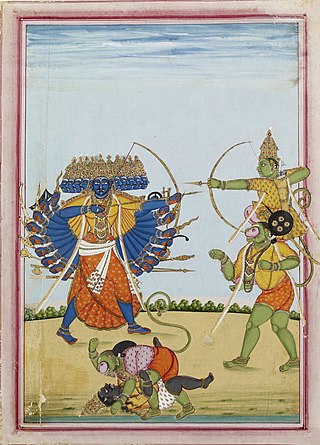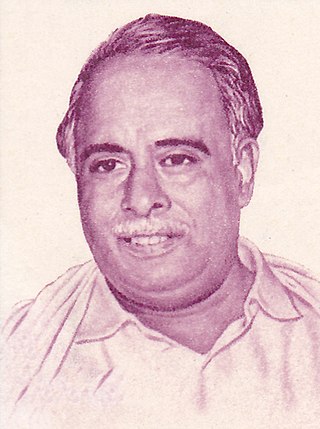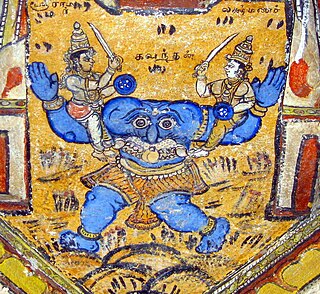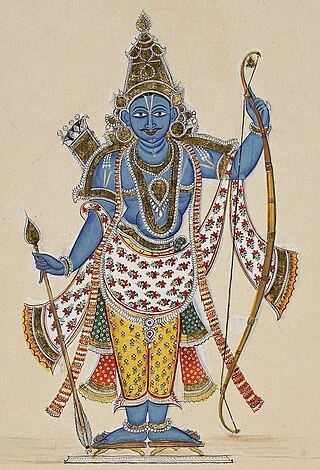Related Research Articles

The Ramayana, also known as Valmiki Ramayana, as traditionally attributed to Valmiki, is a smriti text from ancient India, one of the 2 important epics of Hinduism known as the Itihasas, the other being the Mahabharata. The epic narrates the life of Rama, a prince of Ayodhya in the kingdom of Kosala. The epic follows his fourteen-year exile to the forest urged by his father King Dasharatha, on the request of Rama's stepmother Kaikeyi; his travels across forests in the Indian subcontinent with his wife Sita and brother Lakshmana; the kidnapping of Sita by Ravana, the king of Lanka, that resulted in war; and Rama's eventual return to Ayodhya along with Sita to be crowned king amidst jubilation and celebration.
Indian epic poetry is the epic poetry written in the Indian subcontinent, traditionally called Kavya. The Ramayana and the Mahabharata, which were originally composed in Sanskrit and later translated into many other Indian languages, and the Five Great Epics of Tamil literature and Sangam literature are some of the oldest surviving epic poems ever written.

Kambar or Kavichakravarthy Kamban was an Indian Tamil poet and the author of the Ramavataram, popularly known as Kambaramayanam, the Tamil version of the epic Ramayana. Kambar also authored other literary works in Tamil, such as Tirukkai Valakkam, Erelupatu, Silai Elupatu, Kangai Puranam, Sadagopar Antati and Saraswati Antati.

The Ramavataram, popularly referred to as Kamba Ramayanam, is a Tamil epic that was written by the Tamil poet Kambar during the 12th century. Based on Valmiki's Ramayana, the story describes the legend of King Rama of Ayodhya. However, the Ramavataram is different from the Sanskrit version in many aspects – both in spiritual concepts and in the specifics of the storyline. This historic work is considered by both Tamil scholars and the general public as one of the greatest literary works in Tamil literature.

Kumbhakarna is a powerful rakshasa and younger brother of Ravana from the Hindu epic Ramayana. Despite his gigantic size and appetite, he is described as a virtuous character and a great warrior in Hindu texts. He is said to have slaughtered 8,000 vanaras over the course of Rama's mission to rescue Sita.

Conjeevaram Natarajan Annadurai, popularly known as Anna, also known as Perarignar Anna, was an Indian politician who served as the fourth and last Chief Minister of Madras State from 1967 until 1969 and first Chief Minister of Tamil Nadu for 20 days before his death. He was the first member of a Dravidian party to hold either post.

Shurpanakha, is a rakshasi (demoness) in Hindu epic. Her legends are mainly narrated in the epic Ramayana and its other versions. She was the sister of Lanka's king, Ravana, and the daughter of the sage Vishrava and the rakshasi Kaikeshi. Shurpanakha's role in the original epic is small, yet significant.
Dravida Nadu is the name of a proposed sovereign state demanded by the Justice Party led by the founder of the self-respect movement, E.V. Ramasamy Periyar, and the Dravida Munnetra Kazhagam (DMK) led by C. N. Annadurai for the speakers of the Dravidian languages in South India.

In Hinduism, Kabandha is a Rakshasa (demon) who is killed and freed from a curse by the god Rama – an Avatar of Vishnu – and his brother Lakshmana. Kabandha's legend appears in the Hindu epics Ramayana and Mahabharata, as well as in later Ramayana adaptations.
Dravidian parties include an array of regional political parties in the state of Tamil Nadu, India, which trace their origins and ideologies either directly or indirectly to the Justice Party and the Dravidian movement of C. Natesanar and Periyar E. V. Ramasamy. The Dravidian movement was based on the linguistic divide in India, where most of the Northern Indian, Eastern Indian and Western Indian languages are classified as Indo-Aryan, whereas the South Indian languages are classified as Dravidian. Dravidian politics has developed by associating itself to the Dravidian community. The original goal of Dravidian politics was to achieve social equality, but it later championed the cause of ending the domination of North India over the politics and economy of the South Indian province known as Madras Presidency.
Erode Venkatappa Krishnasamy Sampath, usually referred to as E. V. K. Sampath was a prominent politician from Tamil Nadu, India. He was an advocate of the Dravidian Movement of Periyar E. V. Ramasamy and was considered by some as his political heir. He later split from Periyar's Dravidar Kazhagam to form Dravida Munnetra Kazhagam (DMK) along with C. N. Annadurai. In spite of being one of the founders of DMK he later left and formed his own party, by the name, Tamil National Party. Nevertheless, he later merged his party with the Indian National Congress. He is a former Member of Parliament from the constituency of Namakkal.

Erode Venkatappa Ramasamy, revered by his followers as Periyar or Thanthai Periyar, was an Indian social activist and politician who started the Self-Respect Movement and Dravidar Kazhagam. He is known as the 'Father of the Dravidian movement'. He rebelled against Brahmin dominance and gender and caste inequality in Tamil Nadu. Since 2021, the Indian state of Tamil Nadu celebrates his birth anniversary as 'Social Justice Day'.

Rama is a major deity in Hinduism. He is worshipped as the seventh and one of the most popular avatars of Vishnu. In Rama-centric Hindu traditions, he is considered the Supreme Being. Also considered as the ideal man, Rama is the male protagonist of the Hindu epic Ramayana. His birthday is celebrated every year on Rama Navami, which falls on the ninth day of the bright half of the lunar cycle of Chaitra (March–April), the first month in the Hindu calendar.
Ramayana is one of the two major Sanskrit epics of ancient India.
R. M. Veerappan, also referred to as RMV or Rama Veerappan, was an Indian politician, an early Dravidian Leader, and a film producer and screenwriter from the Indian state of Tamil Nadu. He was the founder and leader of the MGR Kazhagam party. He served as a Cabinet Minister in five governments from 1977 to 1996, was a three-time Member of Legislative Council and a two-time Member of the Legislative Assembly. He was the Leader of the House for Legislative Assembly and Leader of ADMK party of the Legislative Council. He was the architect behind the ADMK organization, unified the MGR fan clubs for the party formation. He was called as the 'Chanakya' of AIADMK politics in the 70's and 80's.
The Self-Respect Movement is a popular human rights movement originating in South India aimed at achieving social equality for those oppressed by the Indian caste system, advocating for lower castes to develop self-respect. It was founded in 1925 by S. Ramanathan who invited E. V. Ramasamy to head the movement in Tamil Nadu, India against Brahminism. The movement was extremely influential not just in Tamil Nadu, but also overseas in countries with large Tamil populations, such as Sri Lanka, Burma, Malaysia and Singapore. Among Singapore Indians, groups like the Tamil Reform Association, and leaders such as Thamizhavel G. Sarangapani were prominent in promoting the principles of the Self-Respect Movement among the local Tamil population through schools and publications.
Kamban Adippodi Saw Ganesan was an Indian politician and Tamil activist, writer, historian, and epigraphist. He was known for popularising the Tamil epic Ramavataram through his Kamban Kazhagam organization, and for initiating construction of a temple to the Tamil language in Karaikudi.

Sampoorna Ramayanam is a 1958 Indian Tamil-language Hindu mythological film directed by K. Somu. It is based on Valmiki's Ramayana. The film stars N. T. Rama Rao in the lead role of Rama and Sivaji Ganesan as Bharatha. It was released on 14 April 1958 and ran for over 264 days in theatres, thereby becoming a silver jubilee hit. The film was dubbed into Hindi as Ramayan in 1960.

Ramayana is one of the ancient Indian epics. According to Robert P. Goldman, the oldest parts of the Ramayana date to the mid-8th century BCE. The story is narrated by the saint poet Valmiki and tells the tale of Prince Rama of the city of Ayodhya, who is banished into the forest, accompanied by his wife Sita and half-brother Lakshmana. During the exile, Sita gets kidnapped by the king Ravana of Lanka, and Rama, with the help of a vanara army, rescues Sita from Lanka. The original set in Sanskrit consists of 24,000 verses, and there are several variations in the story narrated in South Asian and South East Asian cultures, across the Indian subcontinent, Thailand and Indonesia, with several versions re-written in various Indian and other Asian languages.

The historicity of Rama, a central figure in Hindu mythology and revered as an incarnation of the Hindu preserver deity Vishnu, has been a topic of scholarly inquiry and debate, that whether Rama has historically existed or not. Rama is celebrated in the ancient Indian epic, the Rāmāyaṇa, which narrates his life, adventures, and moral teachings. While Rama's story is deeply embedded in religious and cultural traditions across South Asia, historical scholars have explored the extent to which the character of Rama might be based on a real historical figure or composite of multiple historical personalities. This exploration involves examining archaeological evidence, literary sources, and comparative mythology to understand the origins and evolution of the Rama tradition and its significance within Hinduism and broader Indian culture.
References
- ↑ "77-year-old Kamban Kazhagam becomes a registered body". The Hindu. 9 July 2015. Archived from the original on 10 February 2018. Retrieved 14 January 2018.
- ↑ "'Kamba Ramayanam' events exceptional". 16 June 2010. Archived from the original on 10 February 2018. Retrieved 16 January 2018.
- ↑ "Focus on Kamban, poet extraordinaire". The Hindu. 23 May 2010. Archived from the original on 10 February 2018. Retrieved 16 January 2018.
- ↑ "Ravana As Antidote". Outlook. 2 November 1998. Archived from the original on 16 January 2018. Retrieved 16 January 2018.
- ↑ "Our many Ramayanas: India's leaders have re-imagined Ram according to their political ideology". The Indian Express. 10 November 2015. Archived from the original on 16 January 2018. Retrieved 16 January 2018.
- ↑ "The Kamban dream". The Hindu. 7 March 2013. Archived from the original on 10 February 2018. Retrieved 16 January 2018.
- ↑ A. GANGATHARAN (9 August 2017). CULTURAL ASPIRATIONS Essays on the Intellectual History of the Colonial Tamil Nadu. Lulu.com. pp. 111–. ISBN 978-1-387-05025-3. Archived from the original on 10 February 2018.
- ↑ Kamath, Rina (September 2000). Chennai. Orient Blackswan. pp. 103–. ISBN 978-81-250-1378-5. Archived from the original on 10 February 2018.
- ↑ "Kamban Kazhagam Australia's 10th Year Celebrations". The Indian Sun. 26 September 2016. Archived from the original on 21 January 2018. Retrieved 21 January 2018.